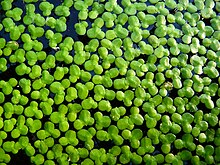Lemna
| Lemna | |
|---|---|
 |
|
| Common duckweed (Lemna minor) | |
| Scientific classification | |
| Kingdom: | Plantae |
| (unranked): | Angiosperms |
| (unranked): | Monocots |
| Order: | Alismatales |
| Family: | Araceae |
| Subfamily: | Lemnoideae |
| Tribe: | Lemneae |
| Genus: |
Lemna L. |
| Synonyms | |
|
|
Lemna is a genus of free-floating aquatic plants from the duckweed family. These rapidly growing plants have found uses as a model system for studies in community ecology, basic plant biology, ecotoxicology, and production of biopharmaceuticals, and as a source of animal feeds for agriculture and aquaculture. Currently, 14 species of Lemna are recognised.
These duckweeds were previously placed in a separate flowering plant family, the Lemnaceae, but they are now considered to be members of the Araceae.
Lemna species grow as simple free-floating thalli on or just beneath the water surface. Most are small, not exceeding 5 mm in length, except Lemna trisulca, which is elongated and has a branched structure. Lemna thalli have a single root, which distinguishes this genus from the related genera Spirodela and Landoltia.
The plants grow mainly by vegetative reproduction: two daughter plants bud off from the adult plant. This form of growth allows very rapid colonisation of new water. Duckweeds are flowering plants, and nearly all of them are known to reproduce sexually, flowering and producing seed under appropriate conditions. Certain duckweeds (such as L. gibba) are long-day plants, while others (such as L. minor) are short-day plants.
When Lemna invades a waterway, it can be removed mechanically, by the addition of herbivorous fish (e.g. grass carp), or, inadvisedly, treated with a herbicide.
The rapid growth of duckweeds finds application in bioremediation of polluted waters and as test organisms for environmental studies. It is also being used as an expression system for economical production of complex biopharmaceuticals.
...
Wikipedia
